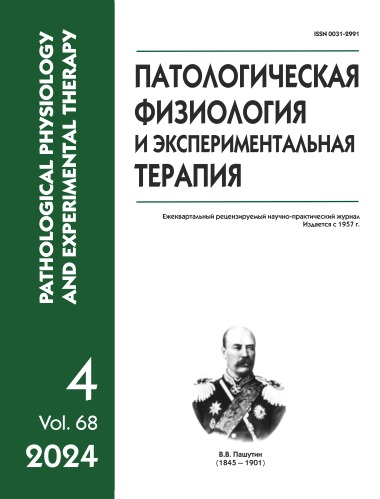The effect of bacterial polyamines on the production of the class G immunoglobulins in the culture of mononuclear leukocytes from healthy donors
Abstract
Polyamines synthesized by microorganisms during the metabolism of amino acids have a versatile effect on the innate immune system. Thus, putrescine and cadaverine are able to inhibit the phagocytic activity of mononuclear leukocytes, and act as a "scavenger" of hydroxyl radicals in the focus of inflammation. However, there is no unambiguous data in the modern literature regarding the effect of polyamines of bacterial origin on the subsystem of adaptive immunity. The aim of the study was to evaluate the effect of cadaverine and putrescine on the production of immunoglobulin G in the culture of mononuclear leukocytes from practically healthy donors. Materials and methods. The object of the study was peripheral venous blood leukocytes from 15 practically healthy donors. Laconose mitogen PWM was used as a B-cell stimulator. Cadaverine and putrescine were used in final concentrations of 5, 25, 50, 75 and 100 mmol/l. At the end of the incubation period, the concentration of immunoglobulins G was determined using the enzyme immunoassay method. Results. A direct relationship was revealed between the concentration of cadaverine and putrescine in the samples and the level of immunoglobulins G (r=0.92 and r=0.98, respectively, p<0.05). Both polyamines had a stimulating effect on IgG production only at concentrations of 75 and 100 mmol/L. Thus, at 75 mmol/l of cadaverine, the level of immunoglobulins was 17.8 IU per 1 mg of protein (p=0.047 for control samples), and at 100 mmol/l - 21.8 IU per 1 mg of protein (p=0.001 for control samples). At a putrescine concentration of 75 mmol/l, the immunoglobulin level was 18.9 IU per 1 mg of protein (p=0.004 for control samples), and at 100 mmol/l - 20.6 IU per 1 mg of protein (p=0.003 for control samples). Conclusion. It was found that the bacterial metabolites putrescine and cadaverine have a stimulating effect on the production of class G immunoglobulins by lymphocytes.
Downloads
References
2. Godovalov A.P., Karpunina T.I., Nesterova L.Yu., Morozov I.A. Polyamines as receptor-independent factors of aggression of opportunistic microorganisms. Immunopathology, Allergology, Infectology. 2019; 3: 91–94.
3. Shah P., Swiatlo E. A multifaceted role for polyamines in bacterial pathogens. Molecular microbiology. 2008; 68 (1): 4–16.
4. Kurihara S. Polyamine metabolism and transport in gut microbes. Bioscience, biotechnology, and biochemistry. 2022; 86 (8): 957–966.
5. Liu G., Zheng J., Wu X., Xu X., Jia G., Zhao H. et al. Putrescine enhances intestinal immune function and regulates intestinal bacteria in weaning piglets. Food Function. 2019; 10: 4134–4142.
6. Carriche G.M., Almeida L., Stüve P., Velasquez L., Dhillon-LaBrooy A., Roy U. et al. Regulating T-cell differentiation through the polyamine spermidine. The journal of allergy and clinical Immunology. 2021; 147 (1): 335–348.
7. Puleston D.J., Baixauli F, Sanin D. E., Edwards-Hicks J., Villa M., Kabat A.M. et al. Polyamine metabolism is a central determinant of helper T cell lineage fidelity. Cell. 2021; 184: 4186–4202.
8. Hesterberg R.S., Cleveland J.L., Epling-Burnette P.K. Role of polyamines in immune cell functions. Medical sciences . 2018; 6 (22): 1-19.
9. Bukharin O.V. Adaptive strategies for the interaction of the pathogen and the host during infection. Bulletin of the Russian Academy of Sciences. 2018; 88 (7): 637–643.
10. Panda S., Zhang J., Tan N.S., Ho B., Ding J.L. Natural IgG antibodies provide innate protection against ficolin-opsonized bacteria. The EMBO journal. 2013; 32(22): 2905–2919.
11. Napodano C., Marino M., Stefanile A., Pocino K., Scatena R., Gulli F. et al. Immunological role of IgG subclasses. Immunological investigations. 2021; 50(4): 427–444.
12. Cruz A.R., Bentlage A.E., Blonk R., de Haas, C.J.C., Aerts P.C., Scheepmaker L.M. et al. Toward understanding how Staphylococcal protein A inhibits IgG-mediated phagocytosis. Journal of immunology. 2022; 209(6): 1146–1155.






